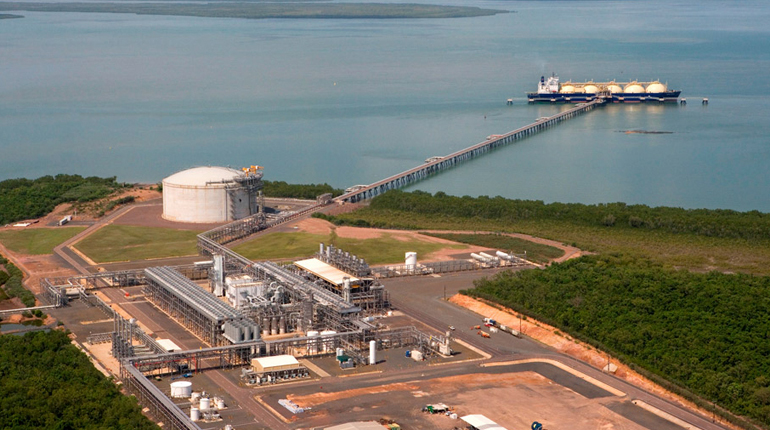 The Darwin LNG plant. Collaboration may be needed for Australian LNG to become competitive. (Conoco)
The Darwin LNG plant. Collaboration may be needed for Australian LNG to become competitive. (Conoco)
While newly minted Australian LNG is currently some of the most expensive around, several of the country’s export projects could become cost-competitive with the world’s cheapest supply within the next decade.
However, experts have said that industry players will need to collaborate to make it happen.
"It’s going to require industry collaboration for those opportunities to be realised […] Australia has a really poor history of collaboration, but the drop in oil prices has focused the industry," Wood Mackenzie analyst Saul Kavonic told Interfax Natural Gas Daily this week.
Kavonic suggested there was an incentive to change attitudes. "Our analysis shows that, if collaborative solutions are found, backfill volumes are likely to be among the lowest-cost new LNG volumes you are going to find anywhere in the world, so there is a value proposition there. They will be able to compete for market share, so there is that impetus to make the collaboration work," he said.
Graeme Bethune, chief executive of consultancy Energy Quest, told Interfax Natural Gas Daily the planned expansion of LNG projects on Australia’s west coast was subject to the overall state of the global LNG market.
"One advantage of the west coast projects is that they have liquids to varying degrees, so if you assume a higher oil price this would help expansion in addition to the efficiencies of debottlenecking and brownfield expansion," he said.
On the backfill side, spare capacity on the North West Shelf will become available by 2021, as well as at Darwin LNG around 2023 and Shell’s Prelude FLNG by 2025. This means any backfill programme will need to be sanctioned up to five years beforehand.
Wood Mackenzie believes a significant portion of the volumes that would be available from debottlenecking would be cost-competitive – even with the cash costs of United States LNG – and could be developed profitably even in a depressed market.
It’s not over yet
While Kavonic acknowledged Australia’s recent LNG projects have not achieved the rate of return that was expected when they were sanctioned, he cautioned against writing off future projects.
"On the surface, it’s a really bleak outlook for new Australian LNG volumes. So do we call it a day? Woodmac’s view is that it’s not over yet," Kavonic said.
Woodmac believes Australia could deliver up to 22 mtpa of new LNG volumes by 2030 that would be competitive with the lowest-cost pre-FID projects globally. "With over US$150 billion of LNG infrastructure being put in place, Australia has an opportunity to supply new volumes at lower cost by making the most of this infrastructure base," Kavonic said.
There is potential for new Australian volumes to displace up to 20% of alternate global supply growth by 2030, he added.
"Once this investment wave is over and projects are operational, we will start to see additional low-cost volumes from Australia through debottlenecking and backfill that will be competitive with the lowest-cost competing projects worldwide," Kavonic said.
"We’re talking up to 20 mtpa by 2025, 30 mtpa by 2030, which could realise up to $10 billion of value. Of this, up to 13 mt by 2025 would be from debottlenecking and backfill, and the rest could come from a brownfield train expansion," he added.
A problem of ownership
While debottlenecking is a relatively straightforward gain through plant optimisation and technical adjustments, backfill and brownfield resources are less assured. This is because the best upstream field candidates have different equity ownership structures from the LNG plant infrastructure.
Aussie brownfield expansions provide further low-cost supply potential, but only from certain projects and only if conditions are right. Projects offering the most potential include "an additional train at Pluto, or Gorgon Train 4, or potentially an extra train at Darwin or Ichthys", but would most likely not appear until "the second half of next decade", Kavonic said.
The expansion of LNG facilities on Australia’s east coast is less likely. "Given the constraints in the upstream CBM supply, we’re more uncertain about the ability to add extra capacity there. Of the recent wave of projects, it’s the east coast CBM projects that have fared the worst in terms of life-cycle economics – and that’s because of their challenging and costly upstream CBM supply," Kavonic said.
But Bethune disagreed. "Australia Pacific LNG has scope for debottlenecking, and Queensland Curtis LNG has scope for debottlenecking and brownfield expansion under Shell’s operatorship with gas from Arrow. The absence of liquids means additional east coast supply will probably be more expensive than west coast expansion, but it could well be cheaper than greenfield development elsewhere in the world," Bethune added.
We welcome your comments. Email us at [email protected].







Talk to us
Natural Gas Daily welcomes your comments. Email us at [email protected].